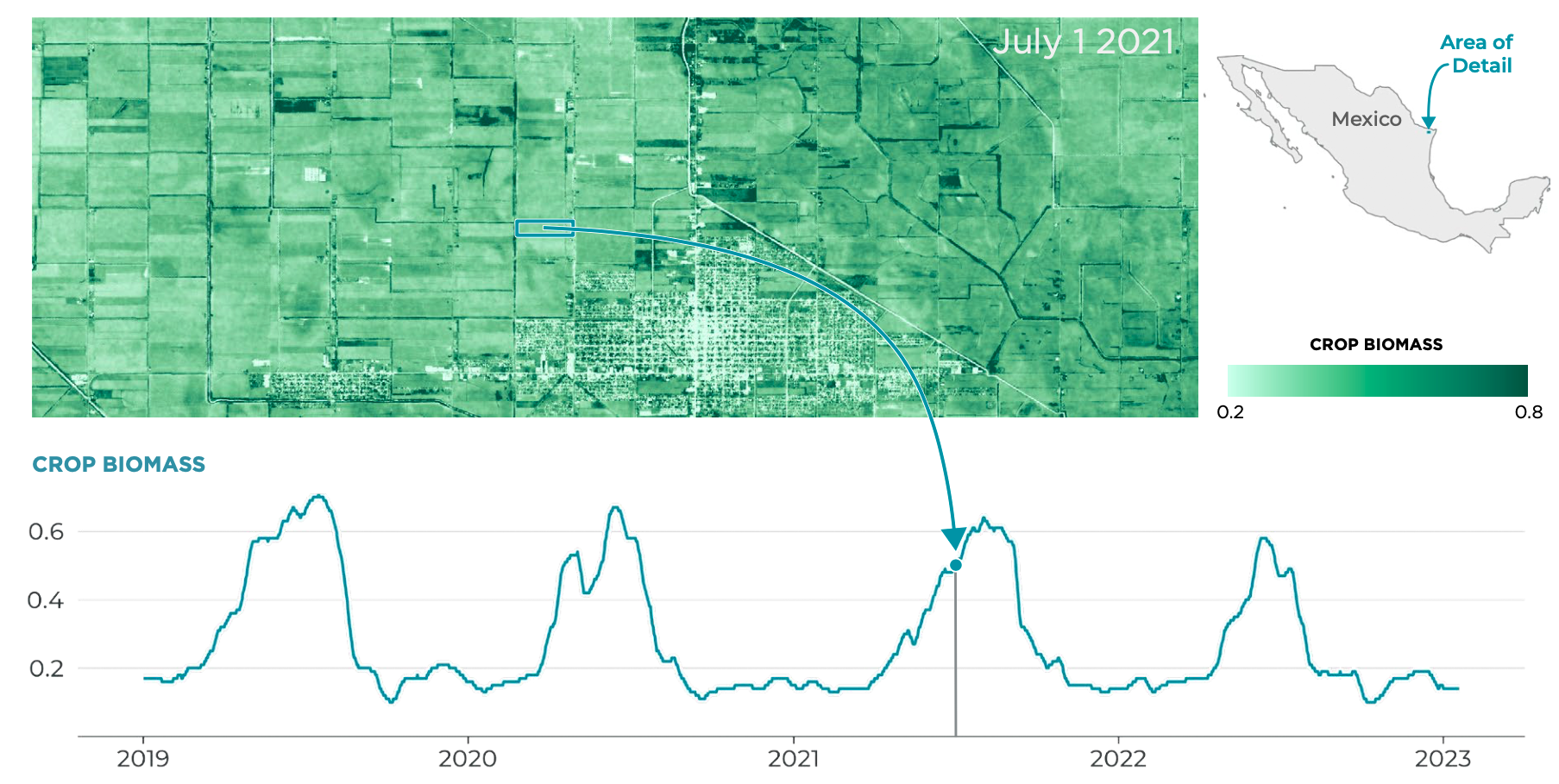Crop Biomass in agricultural fields is highly dynamic, changing throughout the growing season as plants grow, encounter stressors, and approach harvest. The Planet's Crop Biomass provides a cloud-free estimation of the vegetation biomass at a 10-meter resolution on a daily basis.
This data is currently used to monitor +800k fields covering +10M hectares around the world. Daily monitoring enables farmers and agronomists to track and compare the status of their fields, and to detect earlier issues that can reduce yield such as pests, diseases, and water and nutrient deficiencies. In addition, the Crop Biomass data serves as the basis for variable-rate seeding, irrigation, fertilizer and pesticide prescriptions in different crops including maize, soybeans, wheat, cotton, sugarcane, and rice, among others.
Note
Check out the technical specification for more detailed information.
 Figure 1: Crop Biomass data near Valle Hermoso, Mexico. The image above represents crop health in one agricultural field from July 1, 2021. Below, the average Crop Biomass reading from that field is plotted over four years, showing how each season’s crops performed throughout the growing season from emergence to harvest.
Figure 1: Crop Biomass data near Valle Hermoso, Mexico. The image above represents crop health in one agricultural field from July 1, 2021. Below, the average Crop Biomass reading from that field is plotted over four years, showing how each season’s crops performed throughout the growing season from emergence to harvest.
Use Cases¶
Agriculture¶
- Monitor crop growth and development: You can track the growth and development of crops throughout the growing season, helping them to identify any issues early on and take appropriate action.
- Detect and respond to stressors: Frequent updates on Crop Biomass data can help you detect stressors such as pests, diseases, or nutrient deficiencies. Timely access to this information allows you to respond more quickly and effectively, minimizing potential negative impacts on crop health and yield.
- Optimize inputs and interventions: By tracking biomass dynamics, you can make better-informed decisions about the timing and application of inputs such as fertilizers and pesticides, as well as plan targeted interventions to address issues in specific areas of the field.
- Improve harvest planning and efficiency: Access to up-to-date Crop Biomass data can help you plan harvests more effectively, by identifying areas of the field with higher biomass that may require adjusted harvest strategies or equipment settings.
- Estimate crop yield: Peer-reviewed scientific article in Field Crops Research: Planet’s Biomass Proxy for monitoring aboveground agricultural biomass and estimating crop yield Guillevic et al., 2024
Basic Specifications¶
Version 4 released
The new version includes features that provide a better representation of the spatial distribution of the data. PlanetScope is now incorporated as a source of optical data, complementing the Sentinel-2 data feed. In addition, during periods of persistent cloud cover, the Crop Biomass is relying more heavily on the spatial data from Sentinel-1.
| Source id | BIOMASS-PROXY_V4.0_10 |
|---|---|
| Pixel size | 10 m |
| Temporal resolution | 365 observations/year |
| Geographical coverage | Global |
| Data availability | 2019 to present |
Data Access¶
- Access Crop Biomass data through our APIs:
- Check out these code examples:
- Jupyter Notebook that accesses CB through the Planet Subscriptions API and creates data visualizations.
- Collection of custom scripts for Sentinel Hub, including a script to visualize Crop Biomass in EO Browser.
- Explore Planet Sandbox Data on Sentinel Hub.
- Jupyter Notebooks that demonstrates use-cases using Crop Biomass collection using the Sentinel hub Processing API.
Documentation and Training¶
- Explore the technical specification for more detailed information about the product.
- Follow the Intro to Crop Biomass course to get started.
Published Scientific Peer-Reviewed Articles:¶
- The Biomass Proxy: Unlocking Global Agricultural Monitoring through Fusion of Sentinel-1 and Sentinel-2 Burger et al., 2024
- Planet’s Biomass Proxy for monitoring aboveground agricultural biomass and estimating crop yield Guillevic et al., 2024
Blog Posts¶
- Planet's Crop Biomass for Agriculture Monitoring and Yield Forecasting
- Next Generation Agriculture Monitoring at Scale with Planet's Crop Biomass
Engage with Planet¶
We are continually working to improve our technical documentation and support. Please help by sharing your experience with us.